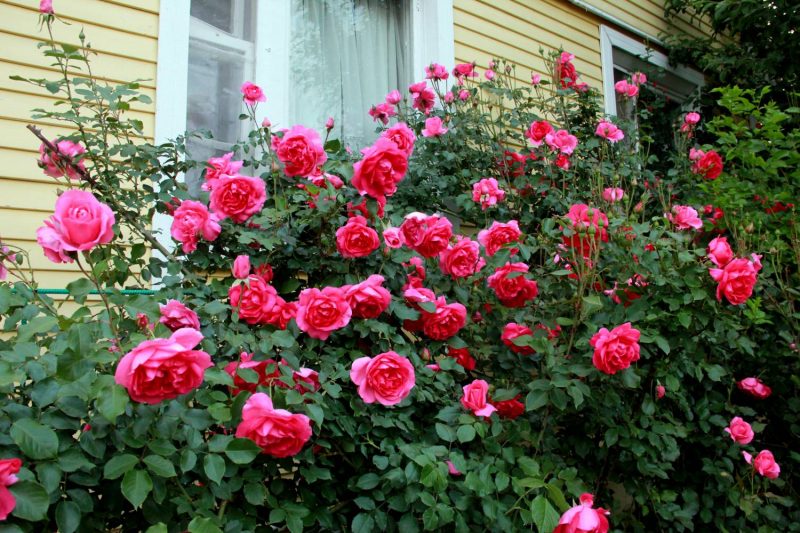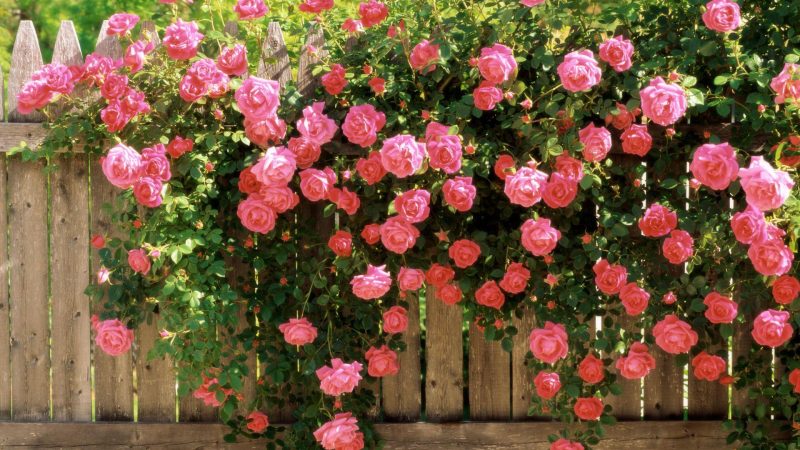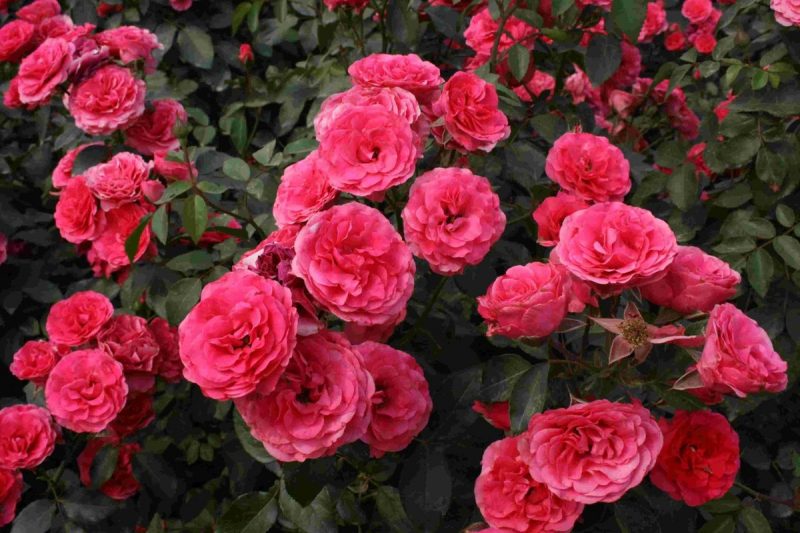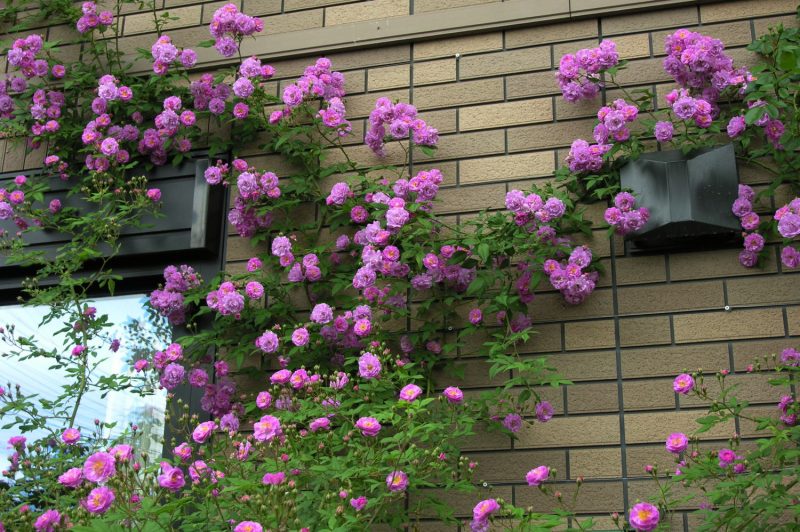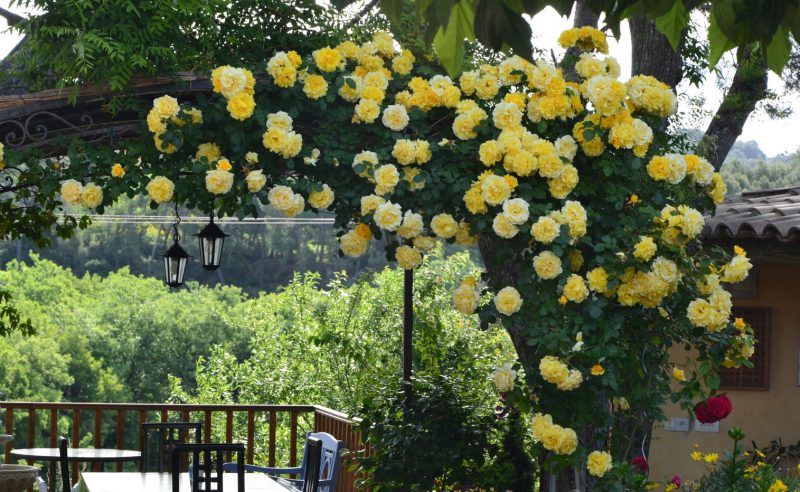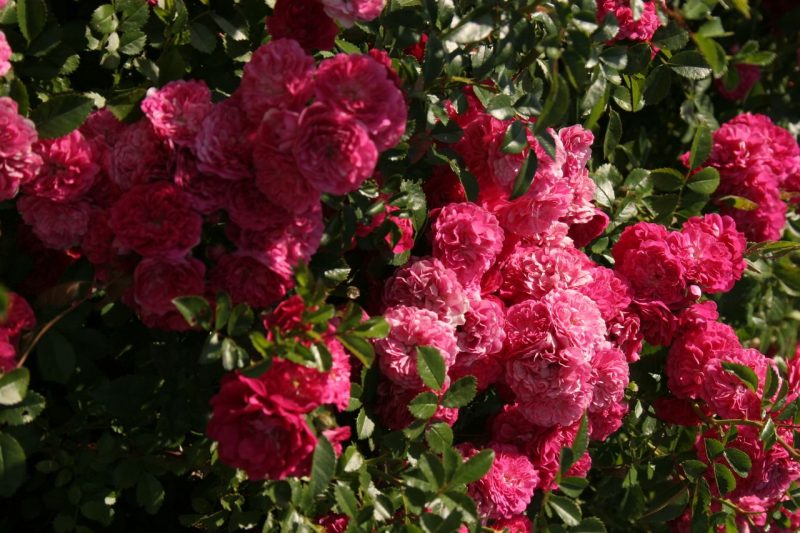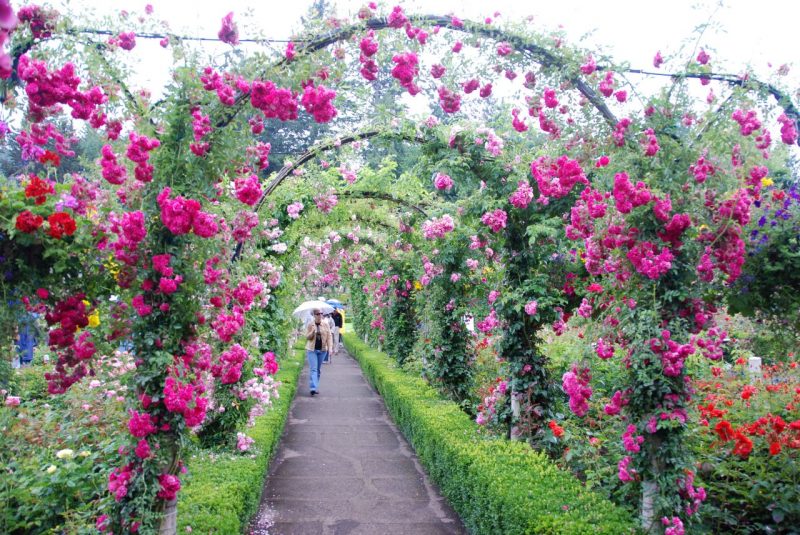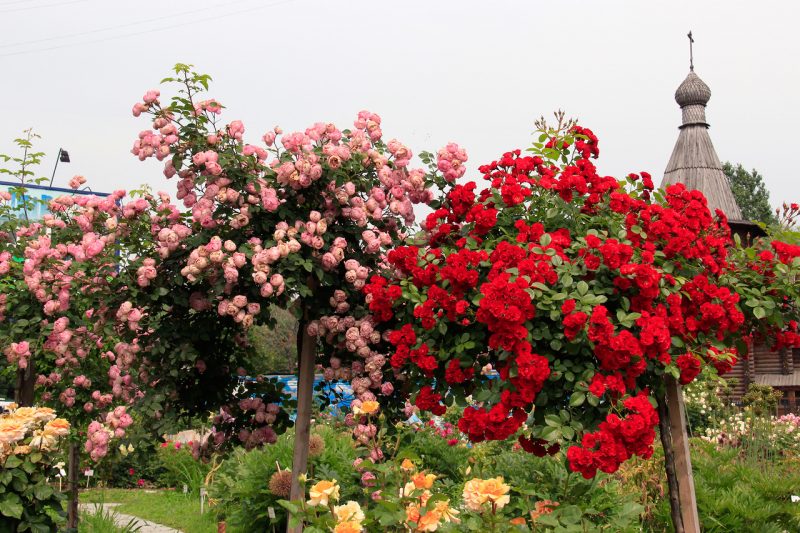The supports, twined with roses from top to bottom and strewn with flowers, are a wonderful decoration of the garden. They can be placed near a bench in the garden, on a flower bed or along garden paths. The climbing rose decorates the wall of the house, the fence or the gazebo, creating a wonderful accent for the entire site. Which grade is best to choose, how to plant and care, - read the article.
Material Content:
Types of climbing roses and their characteristic differences
Curly roses in landscape design play a special role, thanks to the long, flexible shoots they are used for vertical gardening. There are several classification options for climbing roses.
By the nature of growth, they are divided into three groups:
- climbing - from 3 to 5 m;
- semi-braided - from 1.5 to 3 m;
- curly - from 5 to 15 m.
In addition, climbing roses can be root or grafted on a wild rose. The old climbing roses include the rambler group.
Since ancient times, gardeners have grown two types of small-flowered climbing roses - evergreen and field. The hybrids received from them gave birth to many famous varieties.
A characteristic feature of rambler roses is small flowers (from 1.5 to 5 cm), collected in multi-flowered brushes. The length of thin flexible shoots is from 1.5 to 10 m. The leaves are glossy, small in size, slightly elongated. Flowering is continuous, repeated or single, depending on the variety.
By repeatedly crossing ramblers with floribunda roses, tea and hybrid tea, varieties with a height of up to 5 meters were produced - klaimbers. The flowers of this species are relatively large, they are located singly or in loose inflorescences.Plants are winter hardy and have good immunity to fungal diseases.
There are also climbing roses, which appeared due to the kidney mutations of bush varieties of roses. They are called klaymbings. Plants differ from parental forms in long shoots. Large flowers cut from a bush are difficult to distinguish from hybrid tea large-flowered roses. They are suitable for cultivation in southern areas with warm winters.
Popular varieties
The varieties of climbing roses listed below bloom once.
Most of them belong to the group of ramblers:
- Alchemist (Alchymist). Coloring flowers cannot be described in one phrase. She, according to eyewitnesses, is magical - from golden-orange it gradually turns into pink with coral shades. The aroma is very pleasant, intense.
- Goldfinch The lashes are relatively small for ramblers, up to 3 m. The flowers are creamy yellow, with a gradual transition to a cream shade. The variety is resistant to powdery mildew, blooms at the base of last year's shoots, and therefore tolerates short pruning.
- Flammentanz (Flammentanz) - flowers of bright red color, double, flowering once, lasts about 1 month. This hybrid variety is hardy to adverse growing conditions, diseases and frosts, does not need shelter for the winter. Bushes up to three meters in height.
Repair disease resistant
The Climbers group described below is erect, branched bushes about 2.5 m in height, blooming all summer and characterized by resistance to disease.
- Indigoletta (Indigoletta) - unusual lilac flowers with a pink tint, goblet-shaped buds, heat-loving variety.
- Golden Gate (Golden Gate) - blooms in large, yellow flowers up to 10 cm in diameter. The aroma is delicate fruity, with lemon notes.
- Laguna (Laguna) - flowers are densely double, pink, with a strong pleasant aroma. The foliage is shiny, dark green. The variety is thermophilic, frost resistance –23 ° C.
- Rosarium (Rosarium Uetersen) - coral-colored flowers are large, double, have a light aroma. They consist of more than 100 petals, resistant to rain. The flowers collected in large brushes cover the bush from top to bottom during flowering. The variety is winter-hardy and unpretentious in care.
- Rose polka (Polka 91) - delicious flowers of a bright apricot color fade in the sun, becoming cream. Wavy petals give the terry flower even more splendor.
Site selection and site preparation
The place for planting roses is chosen sunny and well-ventilated. Walls or vertical supports oriented to the south are best.
It is advisable to prepare the site in the fall, dig the land and make organic fertilizers - rotted manure, wood ash, compost in combination with full mineral fertilizer. A strip of land 60 cm wide will suffice.
In the spring, at the end of April, they begin landing. Pits for seedlings are dug up in advance so that the earth settles a little. The size of the holes is about 50x50 cm. The day before planting, rotted manure is introduced - 1/2 bucket in each hole, watered.
Landing Features
Saplings begin to sell in January or February. At this time, you can choose the desired variety, but it will be difficult to save the plant until spring planting in sleep form. When the buds begin to wake up, it is better to plant the rose in a container with light fertile soil, and in the spring move it to the garden to a permanent place. Container roses should be planted, trying not to damage the earthen lump when the buds in the trees open.
For a seedling with sleeping buds, the best time to plant in the open ground is early spring, as soon as warm weather sets in, without frost.
The shoots of climbing roses are cut off by about one third, removing all dry, damaged twigs and roots. For better survival, you can soak the rose in a rooting solution before planting, and then pour the solution under the bush.
It is important to ensure that the roots of the seedling in the hole are straightened.The root neck should be 5 cm below the surface of the soil.
Planting a climbing rose ends with compaction of the earth around the plant and watering. The sapling is spudded by 10-15 cm and covered with a mini greenhouse from a plastic bottle.
The subtleties of caring for planted bushes
Care for rose bushes is watering, fertilizing and pruning. After flowering, wilted inflorescences need to be cut so that the rose does not lose power on setting seeds. Water rarely, but abundantly, once every 7 to 10 days.
In the first year, the plant will use fertilizers planted during planting. Then you will need top dressing, approximately 3-4 times per season: 2 times in spring, before flowering, 1 time after flowering and at the end of summer.
Blooming climbing roses do not feed. Fertilizer during this period accelerates the opening of buds, shortens flowering.
- After flowering, they are fed with horse manure infusion or complex fertilizer for roses with trace elements. They bring wood ash under the bushes to accelerate the maturation of young shoots.
- From the middle of summer all feeding is stopped. Otherwise, many young shoots will grow that will not have time to ripen by winter. Under cover, they will begin to rot, and the rose will winter poorly.
- At the end of August, phosphorus-potassium fertilizers can be applied under roses.
It is imperative to conduct annual pruning of shoots for proper bush formation. With good care for the season, the lashes grow by 2 meters. In winter, the rose is removed from the support, bent to the ground and build shelter for it.
Breeding methods
Climbing roses propagate well by cuttings. For cuttings in July, flowering or already faded shoots are chosen. Young green branches are not suitable for this.
On the cut, the flower and lower leaves are cut. Shoots with a heel, a piece of old wood, take root well. The length of the handle should be about 10 cm. The leaves are shortened so that they evaporate less moisture. It is enough to leave 2 sheets on the handle.
Planting cuttings:
- For rooting, take a small flower pot and good, loose soil.
- They stick a stalk into the moist soil, cover it with a plastic cropped bottle.
- Put the seedling in the shade, where the air temperature should be 22 - 25 ° C. In cool weather, root formation is delayed, so it is better to bring the stalk into a house or a greenhouse.
Roots should appear in about a month. To speed up this process, you can water the seedling "Heteroauxin" or "Kornevin."
Types of supports for weaving roses
You can draw attention to the flowerbed with the help of vertical supports in the form of pillars, columns or obelisks, entwined with climbing roses. There is a beautiful decorating technique, when the posts are placed in a row at a certain distance from each other, between them are stretched ropes hanging in the form of semicircles. When weaving roses wrap around pillars and descend in flexible shoots along the ropes, beautiful flowering festoons are obtained.
Obelisks are used as a vertical support for weaving roses in the middle of a flower garden or on a lawn. They are low columns or pyramids that are twined with roses.
Such obelisks can be bought at a store or made independently from iron bars or wooden bars. A DIY rose support made of simple, non-trimmed sticks will create a beautiful contrast with delicate colors.
Vertical trellises and lattice fences are suitable for decorating a flat surface with roses. This is a great option to protect the yard from uninvited guests and prying eyes.
It is interesting:perennial plants perennial and winter-hardy
Diseases and Pests
Modern varieties of climbing roses have good immunity from certain fungal diseases. But under adverse weather conditions or malnutrition, they become vulnerable, affected by pests and diseases.
Common diseases and means of control:
- Powdery Mildew A white powdery coating appears on the leaves, which eventually acquires a gray color.The leaves dry, the stalk is deformed, the buds dry, never opening. For the prevention of the disease, spraying with iron sulfate is used in early spring, before buds open (300 g of vitriol per 10 l of water).
- Gray rot. Stems, leaves, buds rot. The plant ceases to bloom and may die. To combat the disease, a Bordeaux mixture is used (100 g per bucket of water), the affected branches are cut and burned.
- Rust. The shoots crack at the base, spores in the form of a yellow powder are visible from the cracks, brown ulcers form on the stems, leaves are covered with rounded yellow spots. To prevent the disease in the spring, before budding, the bushes are treated with copper sulfate (300 g per bucket of water).
Dangerous pests of roses and protective measures:
- Thrips are small brown insects that feed on the sap of the plant. To destroy pests before flowering, roses are sprayed with "Fufanon", "Intavir", "Karbofos", "Iskra".
- Spider mite. It dwells on the underside of leaves, sucks out juice from them and braids with cobwebs. To combat the tick use acaricides or wormwood infusion (600 g of grass per 10 liters of water, insist 14 days, dilute 1 to 10).
- Rose sawfly. The rose is damaged by sawfly larvae, eating shoots from the inside. Insecticides are used to control insects, as against thrips.
- Rosaceae cicada is a greenish insect with wings. It feeds on plant juice. Insecticides are used for destruction.
- Rose leaflet. A sign of damage to the plant are leaves twisted into a tube, which then die off. Damaged leaves are cut and burned, bushes are sprayed with insecticides.
- Aphids are green. Small insects multiply rapidly, feed on plant juice. To combat them, use insecticides or a solution of laundry soap (300 g per bucket of water). Rub the soap, dissolve in boiling water.
Caring for climbing roses is easy. The beauty and aroma of these plants justify the effort.


